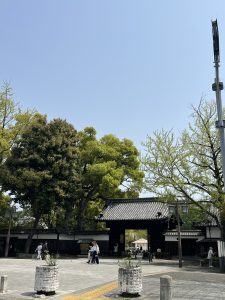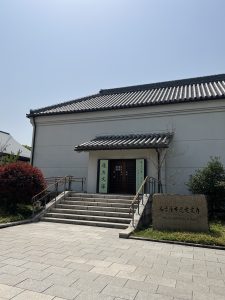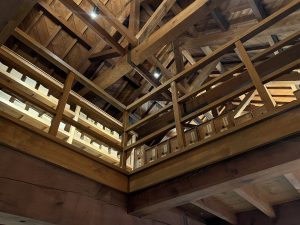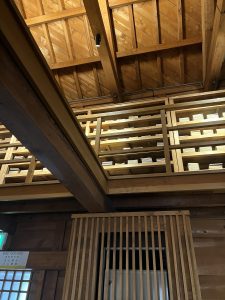ゴールデンウイークの予定がそろそろ気になります。(愛知県名古屋市千種区姫池通 骨董買取 古美術風光舎)
2025.04.19
今朝も、毎年恒例この時期何を着たらいいのか問題に頭を悩ませ、いろいろな服を楽屋みたいに車に投げ込んで通勤してきたのですが、通りすがりの小学生はすでに半袖でありました…笑。まだゴールデンウイークまで時間があるというのにすでに半袖の心配をしなくてはいけないようですね。
今朝はそんな半袖の小学生を横目に街を抜け、徳川園界隈を通りかかりました。久しぶりだったので、ちょっと園内を通り抜けてきたのですが、結婚式のご一同様が記念撮影していたり、マルシェなるものも開催されており、お天気も相まってとてもいい休日です。


徳川美術館や徳川園へ立ち寄る時間はなかったので、仕方なく通り抜けようとしたところ、園内の「蓬左文庫」(ほうさぶんこ)が目に留まりました。

どうやら入口の建物はご自由にお入りくださいになっておりましたので、(実は一度も入ってみたことが無かったので)ちょっと覗いてみたくなりました。
この入口のこの建物は昭和58年まで蓬左文庫の書庫として使用していた建物(明治33年新築、昭和10年改築)を玄関ホールに再利用したものなのですが、内部は「河内本源氏物語」などの代表的蔵書の複製展示とともに、2階部分に再現された和装本の収蔵の様子も見ることが出来るようです。平成26年10月7日には国の登録有形文化財(建造物)に登録されております。
よく時代物のTVで書物などが棚に整然と並んでいるシーンを見ることがありますが、1階から2階を仰ぎ見ると、まさにそんな様子ですね。西洋の書物のようにハードな装丁ではありませんので、寝かせて保存のスタイル。



ところで、蓬左文庫(ほうさぶんこ)、名古屋にお住いの方でしたらご存知かと思われますが、尾張徳川家の旧蔵書を中心に和漢の優れた古典籍を所蔵する公開文庫であります。現在の蔵書数は約12万点と、蔵書内容の豊富さがこちらの蓬左文庫(ほうさぶんこ)の特徴でして、さらに書籍だけではなく、尾張徳川家に伝えられた2千枚をこえる絵図も所蔵しており、名古屋の城下図から世界図におよぶ古地図や、屋敷図・庭園図など、多彩な内容の絵図が含まれております。蔵書の閲覧のほかに、徳川美術館の大名道具と合わせて、武家の学問と教養など、近世武家文化をわかりやすく紹介する展示や、徳川美術館・徳川園と連携した講演会なども企画開催しております。
蓬左文庫(ほうさぶんこ)の始まりは、尾張藩の書物倉である「御文庫」の創設からなのですが、元和2年(1616)徳川家康の死去により、その遺品の多くが、尾張、紀伊、水戸の御三家に分譲され、このうち、のちに駿河御譲本(するがおゆずりぼん)と呼ばれる家康の蔵書については3千冊が尾張家に譲られ、これを契機に尾張藩の御文庫は形成されていきます。
この後、御文庫の蔵書は歴代藩主の書物収集を中心にその蔵書を拡大し、幕末期の蔵書数は5万点と推定され、江戸時代を通じ、尾張藩の御文庫は質量ともに我が国屈指の大名文庫でありました。ところが、 明治維新後の混乱期には払い出しなどにより蔵書の約三分の一が流出。残った御文庫の蔵書に「御記録所」をはじめとする尾張藩の役所、別邸の蔵書の一部が加わり、尾張徳川家の蔵書として東京と名古屋の屋敷に保管されることとなりました。
とまあ蓬左文庫のはじまりは、名古屋と東京の2拠点だったことは初めて知ったのですが、その後、尾張徳川家が財団法人の設立を構想し始めるのは、明治末から大正初期あたりでして「蓬左文庫(ほうさぶんこ)」の命名もこの頃のことのようです。19代当主徳川義親氏は、江戸時代以来の同家の蔵書にたいし、蓬左城(名古屋城)内にあった書物を伝える文庫という意味を込めて「蓬左文庫(ほうさぶんこ)」と名付けたのが、名前の始まりのようです。
昭和10年には名古屋大曽根邸内に徳川美術館が開館したのと同時に、蓬左文庫(ほうさぶんこ)は東京目白の邸内にも開館します。その後も明治維新から蓬左文庫(ほうさぶんこ)の開館までにも旧尾張藩士の旧蔵書をはじめ多くの資料が蔵書に加えられ、公開文庫の道を歩み始めた蓬左文庫(ほうさぶんこ)だったのですが、戦争によりなんと10年足らずで休館を余儀なくされます。
その後本格的にその歩みを再開したのは、昭和25年の名古屋市移管後のことです。翌年から旧尾張徳川家大曽根邸内の現在地において一般公開が始まり、以後名古屋市教育委員会の管轄下、図書館の分館をへて名古屋市博物館開館にともない、昭和53年よりその分館になり現在の蓬左文庫となっているようです。
現在の蔵書数は約12万点。名古屋市移管後の収集書もすでに6万点近くになり、蔵書内容の豊かさが蓬左文庫(ほうさぶんこ)の特徴のひとつでもあります。
有名な蔵書ですと、河内本源氏物語(重要文化財。源氏物語の河内本系写本のうち、現存最古の完本。鎌倉時代(13世紀)54巻23冊金沢文庫旧蔵書、徳川家康旧蔵書)、続日本紀(重要文化財。鎌倉時代(13・14世紀)および慶長年間(1596から1615)40巻。金沢文庫旧蔵、駿河御譲本)、つれづれ草 奈良絵本(吉田兼好著 江戸時代前期(17世紀)6冊 三代尾張藩主徳川綱誠夫人旧蔵書)などがあります。
そういえば昨年静嘉堂文庫で西暦18-19年の源氏物語の写本の蒔絵箪笥に入った完本を見ることが出来たのですが、こちらの河内本源氏物語の完本はそれよりもさらに古い書物ですので、是非ともいつかはみてみたいものですね。
とまあ、通り過ぎるだけ!と、いいつつも、結局入口だけでも楽しめた蓬左文庫でしたので、もうすぐ訪れるゴールデンウィーク、徳川美術館と共に足を伸ばしてみてもよいのではないでしょうか。
それではごきげんよう(スタッフY)
This morning, I was still pondering the annual problem of what to wear this time of year, and threw various clothes into the car like a dressing room to get to work, but a passing elementary school student was already in short sleeves…lol. It seems that I already have to worry about short sleeves even though there is still time until Golden Week.
This morning, I passed by the Tokugawa-en neighborhood with such short-sleeved elementary school students by my side. It had been a while since I had been there, so I walked through the garden for a while.
We didn’t have time to stop by the Tokugawa Art Museum or Tokugawa Garden, so we were forced to walk through the park, but the “Hosa Bunko” in the park caught our attention.
The building at the entrance was apparently open to the public, so I decided to take a peek (since I had never been in there before).
The building at the entrance of the museum was originally used as the library of the Yomogi Sako Bunko until 1983 (built in 1900 and reconstructed in 1935), and has been reused as an entrance hall. The second floor of the museum is a reproduction of a Japanese book collection. On October 7, 2014, it was registered as a national tangible cultural property (building).
You may often see a scene of books and other items neatly lined up on shelves in a period TV program, and looking up from the first floor to the second floor, you can see just such a scene. Since the books are not hard-bound like Western books, they are laid out and preserved in this style.
By the way, Hosa Bunko, as you may know if you live in Nagoya, is a public bunko that holds excellent Japanese and Chinese classic books, mainly from the old collection of the Owari Tokugawa family. The current collection consists of approximately 120,000 items, and the richness of the collection is a characteristic of the Housa Bunko. The collection also contains a wide variety of maps and drawings. In addition to browsing the collection, the museum plans and holds exhibitions that introduce the culture of samurai families in the early modern period in an easy-to-understand manner, including samurai learning and culture, as well as lectures in cooperation with the Tokugawa Art Museum and Tokugawa Garden, in addition to the daimyo’s tools in the Tokugawa Art Museum.
The Housa Bunko began with the establishment of the “Gobunko,” a library of books of the Owari clan, but after the death of Ieyasu Tokugawa in 1616, many of his belongings were transferred to the three families of Owari, Kii, and Mito. This was the beginning of the formation of the Owari clan’s bunko.
The Gobunko’s collection was later expanded to include books collected by successive lords of the domain, and by the end of the Edo period, the Gobunko was one of Japan’s foremost daimyo bunkos in terms of both quantity and quality. However, during the chaotic period after the Meiji Restoration, about one-third of the collection was lost due to disposals and other reasons. The remaining books from the Gobunko, together with some of the books from the Owari Clan’s government offices and villas, including the “Imperial Records Office,” were stored as the collection of the Owari Tokugawa family in their residences in Tokyo and Nagoya.
I first learned that the Hoza Bunko started in Nagoya and Tokyo, but it was around the end of the Meiji period or early Taisho period that the Owari Tokugawa family began to think about establishing an incorporated foundation. The name “Hosa Bunko” was given by Yoshichika Tokugawa, the 19th head of the Tokugawa family, to the collection of books that had been in the family since the Edo period (1603-1868), and it was named “Hosa Bunko” in reference to the collection of books that had been kept in the Hosa Castle (Nagoya Castle).
In 1935, the Tokugawa Art Museum was opened in the Oosone Residence in Nagoya, and at the same time, the Hosa Bunko was opened in the Mejiro Residence in Tokyo. Many materials were added to the collection from the Meiji Restoration to the opening of the Hosa Bunko, including the old collection of the former Owari feudal lord, and the Hosa Bunko began its path to becoming an open library.
It was not until 1950, when it was transferred to Nagoya City, that it resumed its activities in earnest. The following year, the library was opened to the public at its current location in the former residence of the Owari Tokugawa family, Ohsone, and then became a branch of the library under the jurisdiction of the Nagoya City Board of Education until 1978, when the Nagoya City Museum was opened.
The current collection consists of approximately 120,000 items. The richness of the collection is one of the characteristics of the Hosa Bunko.
One of the best-known items in the collection is the Kawachi-bon Tale of Genji (Important Cultural Property. The oldest surviving complete copy of the Tale of Genji among the Kawachi-bon manuscripts. Kamakura period (13th century), 54 volumes, 23 books, former collection of Kanazawa Bunko, former collection of Ieyasu Tokugawa), Shoku Nihon Ki (Important Cultural Property. Kamakura period (13th and 14th century) and Keicho period (1596-1615), 40 volumes. Nara Ehon (Nara Picture Book, by Yoshida Kenko, early Edo period (17th century), 6 volumes, owned by Mrs. Tokugawa Tsunasei, the third lord of Owari Domain), etc.
By the way, last year I was able to see a complete copy of the Tale of Genji in a maki-e chest at the Seikado Bunko, dating from 18-19 AD, and this complete copy of Kawachi-bon Genji Monogatari is even older than that, so I would definitely like to see it someday.
But I would definitely like to see it someday! However, we enjoyed the Yomogiwa Bunko even just at the entrance, so why not extend your visit during the Golden Week holidays coming soon, along with the Tokugawa Art Museum?
Have a good day (Staff Y)
*********************
新緑の気持ちの良い季節となってまいりました。お片付けしやすい季節でもありますね。
風光舎では、古美術品や骨董品の他にも絵画や宝石、趣味のお品など様々なジャンルのものを買受しております。
お片付けをされていて、こういうものでもいいのかしらと迷われているものでも、どうぞお気軽にご相談下さいませ。
また風光舎は、出張買取も強化しております。
ご近所はもちろん、愛知県内、岐阜県、三重県その他の県へも出張いたします。
まずは、お電話お待ちしております。
愛知県名古屋市千種区・骨董 買取
『古美術 風光舎 名古屋店』
TEL 052(734)8444
10:00-17:00 OPEN

